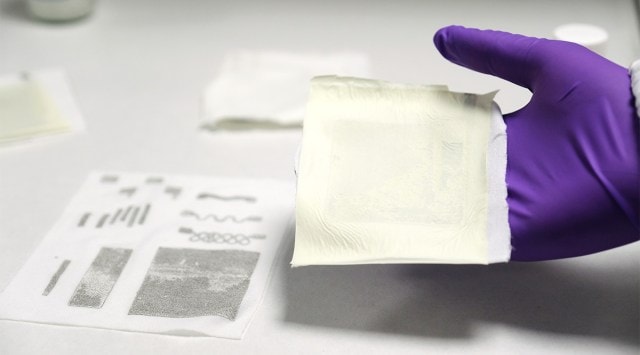- India
- International
This fabric can generate electricity from your movements to power wearables
Tapping a 3x4 cm piece of stretchable and washable fabric generated enough electricity to light up to 100 LEDs.
 The fabric produces electricity in two ways: when it is stretched or squashed and when it comes in contact with other materials like skin or other fabrics. (Image credit: NTU)
The fabric produces electricity in two ways: when it is stretched or squashed and when it comes in contact with other materials like skin or other fabrics. (Image credit: NTU)Scientists at the Nanyang Technological University, (NTU) Singapore have developed a technology that can create a stretchable and waterproof fabric that can generate energy from your body movements. The researchers envision that this fabric can be used to charge small wearable electronic devices like digital watches and fitness bands.
The researchers created a proof-of-concept, which was documented in a research article published in Advanced Materials. They showed that tapping a 3×4 cm piece of the novel fabric generated enough electricity to light up to 100 LEDs.
It produces electricity in two ways: piezoelectricity when it is pressed or squashed and electricity generated due to the triboelectric effect when it comes in contact with or friction with other materials like skin or other fabrics
The researchers also found that washing, folding and crumpling the fabric did not cause any performance degradation. The fabric was also able to maintain stable electrical output for up to five months. According to the researchers, this demonstrates its potential for use as a smart textile and a wearable power source.
“This ‘fabric’ can power small electronic devices, including digital watches, fitness bands, and small liquid crystal display (LCD) screens. It can also be integrated with energy storage devices, such as supercapacitors, which can store the power generated from a person’s daily activity, and drive the electronic devices during his inactive periods, e.g. when resting or sleeping,” said professor Lee Pooi See, corresponding author of the research article, in an email interaction with indianexpress.com.

Pooi See also envisions other applications apart from wearable fabrics. For example, the material could be used to cover roofs, buildings, cups and carpets and other sites and locations to harvest mechanical energy. This mechanical energy can come from the ambient environment like rain, wind and tidal energy, or from human motions like walking, dancing and running. The fabric can also be deployed as a smart sensor to measure the amount of force exerted on an object or fabric through the strength of the electric signal.
 The researchers imagine a variety of applications for the material, including outside power generation. (Image credit: NTU)
The researchers imagine a variety of applications for the material, including outside power generation. (Image credit: NTU)
To create the prototype, Poi See and his team first made a stretchable electrode by screen-printing an ‘ink’ comprising silver and a rubber-like material to make it stretchable and waterproof. This stretchable electrode was then attached to nanofibre fabric that comprised of two materials: a polymer that produces an electric charge when compressed, bent or stretched and lead-free perovskites.
“For our 3cm by 4cm fabric device, the main costs are from the silver electrode and raw materials of perovskites. For the mass market, the total cost will be much lower because of improved production efficiency and the lower price of materials when purchased on a larger scale. The cost of a mass-market product depends on the practical requirements and other factors such as aesthetic design, human-machine interface design, integration of energy storage system and electronic devices, as well as device packaging,” said Pooi See, when asked about what it costs to manufacture such a device.
For the study, the device’s electrical output was only measured for five months but the researchers believed it can still work after that period because output performance was still stable. However, it will be challenging to develop a device with a lifespan that is on part with that expected from the clothes that we wear every day. This is because it is made out of a multilayer structure that might become delaminated. This is one of the biggest challenges the technology will have to overcome in order to become viable for real-world usage.
More Tech
Apr 19: Latest News
- 01
- 02
- 03
- 04
- 05







































